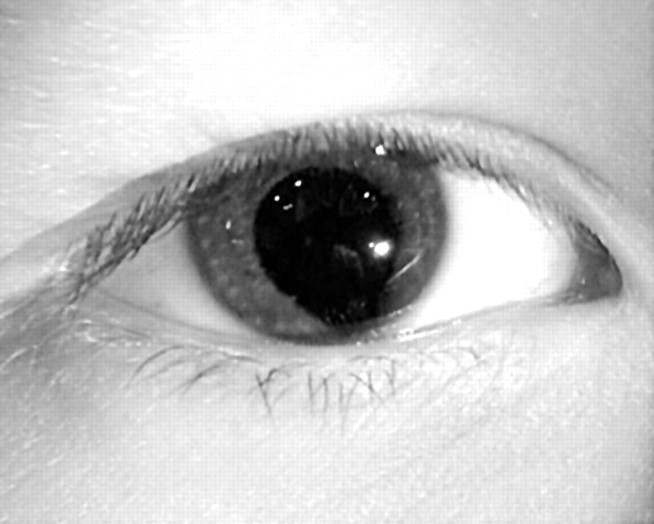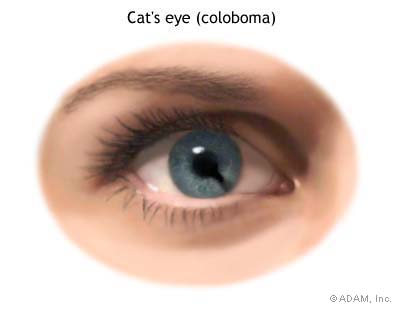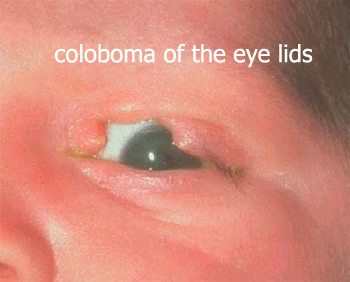The pupils of my eyes are not round, they’re more of a keyhole shape, or an upside-down teardrop. The condition is called coloboma, and is a congenital defect of the eye. Essentially, coloboma is a gap in part of the structure of the eye. The gap can be large or small, but normally appears in the bottom part of the eye. It is caused when a fetus’s eyes do not develop properly during pregnancy.

Coloboma forms while the baby grows in the womb. The eyes normally develop between the fourth and twelfth week of pregnancy, and start off as little buds. Usually the eye folds in on itself as it develops, which leaves a small gap called the foetal cleft. The foetal cleft helps maintain the blood supply to the developing parts of the eye. In the final stage of eye development during pregnancy, the cleft seals up from the back of the eye forwards and all the structures of the eye are formed. In an eye with coloboma, this gap does not fully close and remains in some of the structures of the eye. The condition occurs in about 1 in 10,000 births.
Coloboma can affect one eye (unilateral) or both eyes (bilateral), and can affect a number of different parts of the eye. It can affect the iris which is the colored part at the front of the eye. It can affect the lens, the part of the eye which helps focus light onto the retina. Coloboma can also affect the choroid which is a thin network of blood vessels which help to keep the retina healthy. Finally, it can affect the retina at the back of the eye. Very rarely coloboma can also affect the optic disc or the eyelid.

Coloboma with a more defined "keyhole" shape
In my particular case I have bilateral coloboma, but only the irises are affected. Since the eyes form from the back to the front - that means that the rest of my eyes formed normally and my condition is more cosmetic than anything. My sight is fine, but I do suffer from increased light sensitivity because my pupils are larger than average. The iris, which usually limits the amount of light entering the eye by controlling the size of the pupil, does not work properly as a result of having coloboma and does not dilate normally in bright light. Sunglasses are my friend, and are so essential to my comfort on sunny days that they are almost like a security feature for me – similar to Linus and his blanket.
I am fortunate that the impact to my vision is mild. There are some individuals that have coloboma that are not as fortunate. The effect coloboma has on vision depends a lot on which part of the eye is affected and how big the gap is. Normally the gap is at the bottom of the eye (where a 6 is on the face of a clock) and runs from the front to the back of the eye. Coloboma affects only the front of the eye if most of the cleft has sealed up. It can affect the eye from the front to the center and back if more of the cleft has failed to close. The further back the coloboma goes into the eye, the more visual problems it can cause - especially if the retina is involved. If this has happened then central vision may be affected, and the individual may be legally blind due to the inability of the eye to focus properly. In some cases, coloboma affects not only the eye, but the structure of the eyelid as well.

The existence of coloboma may also be an indicator of other hidden issues – other organs or structures that did not form properly before birth. A child born with coloboma is checked for symptoms of certain syndromes known to include coloboma, such as CHARGE, a rare condition that stands for:
C – coloboma
H – heart defects
A – atresia of the choanae (problems with the nose passages)
R – retarded growth and developments
G – genital hypoplasia (undescended testicles)
E – ear abnormalities
What causes coloboma? Most cases appear without any previous family history. In some families coloboma can be inherited. If a child is diagnosed with coloboma it is advisable for the child's parents to have an eye examination. This is because coloboma can be present without causing any visual problems; therefore a parent might have the condition but not know it.
In my case, there was a distant genetic link. I had a great (great-great?) uncle that had coloboma in one eye. However, I have an older brother and sister, and neither of them have it. I also have three children, and none of them were born with it either (although when they were born I made sure that as soon as the fingers and toes were counted, that their eyes were the very next thing the doctors checked). They all theoretically have the gene though, so it may pop up again in some future generation.
In some cases, coloboma can also be caused by accident, injury, or surgery. The resulting gap in the eye from one of these external causes would have similar impacts to a person’s eyesight, dependent upon the severity and depth of the gap.
There is no “cure” for coloboma. There is no surgical way to close the gap in order to complete the formation of the eye after the fact. For individuals like me that have coloboma of the iris, we compensate with sunglasses and shade hats. For those that have more severe cases involving deeper layers of the eye, unfortunately not much can be done with corrective lenses or surgery to mitigate the impact.
I recognize my fortune in having a very mild case of this condition. The impact to my eyesight and daily life is minimal, and it’s served as a conversation starter at stores and BBQ’s more than anything else. I am not self-conscious of my eyes, and honestly usually forget that they look different until someone else notices them and makes a comment. I am instantly aware of the people that tend to make eye contact when they speak however - because those are the ones that will suddenly stop mid-sentence, crane their necks a little closer, and say, “Hey, your eyes look like cat-eyes!” Or, “Uh, are you wearing contacts?” I have never had anyone be rude though, mostly just curious. And just about everyone is interested in learning more about my eyes, and why they look the way they do.

Yep - that's me
As a kid I never quite understood all the fuss. The subject would sometimes come up during get-togethers at our house, and suddenly I would get trotted out so that those that had heard about my eyes but never seen them could get a look. I was my sister’s show-and-tell item more than once. And there were occasional days in grade school where I heard a “cat-eyes” reference whispered as I went by – but even at that age most kids were curious instead of mean about it.
The very worst part of having coloboma was while growing up in Colorado, walking to school on sunny mornings after a fresh snow. The sunlight reflecting off the snow on the ground was more than I could handle. My eyes would squeeze shut until they were mere slits, yet they would continue to water so much under the strain that tears would roll down my face without end. At this age, my mom would buy me sunglasses – but they would always be lost within an hour. So most times I had no protection, and the only way I could make my way to school was by walking behind my sister and focusing on her shadow on the ground; her shadow was the only respite in an otherwise unending field of bright white light. I would trudge behind her, head down, following that shadow until we would reach the protection and relative darkness of our school building. I would experience such tension during the walk to school on such days, that more often than not I suffered from a headache the rest of the morning. Even today, my “dream city” is Seattle. My favorite days are overcast and cool, since I am neither a fan of sunshine nor heat. My sun-loving husband however disagrees, and instead keeps me comfortably outfitted with sunglasses instead of going house-hunting in Washington state.
He and I did visit Seattle once though, and while we were there we had lunch on top of the Space Needle. Our friendly waitress came over to take our order, and when I looked up at her you’ll never guess what I saw – a pair of eyes just like mine looking back at me! We stopped, looked at each other, and both broke out in a huge smile. For both of us this was the first time we stumbled across someone that shared our rare trait. It was refreshing for once to be the person surprised by an unexpected pair of “cat-eyes.” And the fact that my eye-twin chose to live in Seattle – a coincidence? I think not.





Comments